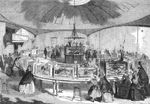Tremont Theatre (Boston)
1827 establishments in Massachusetts1843 disestablishments in the United States19th century in BostonFormer theatres in BostonGreek Revival architecture in Massachusetts ... and 1 more
Theatres completed in 1827

The Tremont Theatre (1827–1843) on 88 Tremont Street was a playhouse in Boston. A group of wealthy Boston residents financed the building's construction. Architect Isaiah Rogers designed the original Theatre structure in 1827 in the Greek Revival style. The playhouse opened on 24 September 1827.
Excerpt from the Wikipedia article Tremont Theatre (Boston) (License: CC BY-SA 3.0, Authors, Images).Tremont Theatre (Boston)
Tremont Street, Boston Downtown Boston
Geographical coordinates (GPS) Address Nearby Places Show on map
Geographical coordinates (GPS)
| Latitude | Longitude |
|---|---|
| N 42.3575 ° | E -71.060833333333 ° |
Address
Tremont Temple
Tremont Street 86;88
02102 Boston, Downtown Boston
Massachusetts, United States
Open on Google Maps








